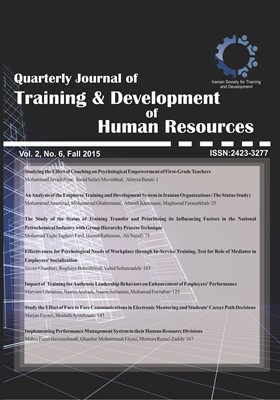-
-
List of Articles
-
Open Access Article
1 - Studying the Effect of Coaching on Psychological Empowerment of First-Grade Teachers
علیرضا براتی -
Open Access Article
2 - An Analysis of the Employee Training and Development System in Iranian Organizations (The Status Study)
Mohammad عموزاد Mohammad مقصود فراستخواه -
Open Access Article
3 - The Study of the Status of Training Transfer and Prioritizing its Influencing Factors in the National Petrochemical Industry with Group Hierarchy Process Technique
mohamad taghi taghavi fard hamid rahimian mortaza taheri -
Open Access Article
4 - Effectiveness for Psychological Needs of Workplace through In-Service Training, Test for Role of Mediator in Employees' Socialization
رقیه بهشتیراد -
Open Access Article
5 - Impact of Training for Authentic Leadership Behaviors on Enhancement of Employees’ Performance
Nasrin Arshadi Mohammad فروهر -
Open Access Article
6 - Study the Effect of Face to Face Communications in Electronic Mentoring and Students’ Career Path Decisions
marjan fayyazi مصطفی ایوب زاده -
Open Access Article
7 - Identifying and Modeling Iranian Large Enterprises’ Motivators in Implementing Performance Management System in their Human Resource Divisions
مهسا فاضل حسنآبادی Ghanbar Mohammadielyasi
-
The rights to this website are owned by the Raimag Press Management System.
Copyright © 2017-2026







